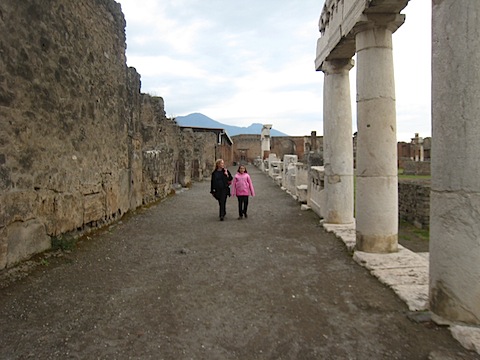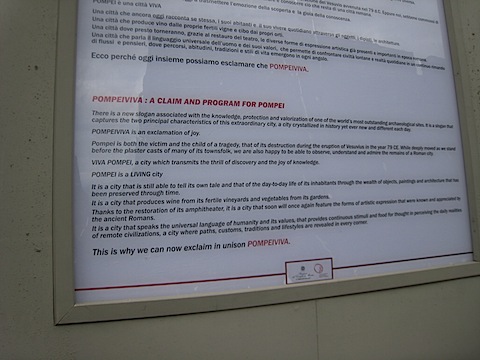It seems that you can’t escape the demands of rebranding, even if you go back 2282 years.

In one of the more intriguing examples of rebranding I’ve seen in a while, the world historical site of the City of Pompeii is currently engaged in its own rebranding campaign.
The ‘old’ brand of Pompeii
To appreciate the rebranding, you need first to consider what Pompeii looks like to the average visitors, like me and my family when we toured Pompeii a few weeks ago.
Pompeii is expansive, silent, passive, and virtually inert.
Were in not for a few archeologists working behind plastic tarps that blocked them from visitors’ views, the only thing that seems to be alive at Pompeii (besides the tourists themselves) are the 7 or so dogs that roam the property.
The place actually feels like a ghost town, which in a way reinforces its historical brand—a place where the past has been partially preserved and recovered, where visitors can stand on thresholds adorned with mosaics laid 2100 years ago or trip along roads stilled rutted by chariot wheels.
The whole experience was a challenge to project with ones imagination back to the time when Pompeii was a living city. This was difficult to do, given the nearly complete absence of curatorial materials to help visitors imagine, interpret and understand what they were seeing. (I’ll save my thoughts on the curatorial presentation of Pompeii for a later post.)
I was glad that we had the Acoustiguides and some well-read schoolchildren to note some of the highlights. As moved as I was by what we could see, and what I could understand, I had many many questions that remained unanswered. I wondered what the ‘rest of the story’ really was at Pompeii.
But then, on the Via dell’ Abbondanza, we came upon an education center, buried inside a multi-story, scaffolded and wrapped excavation site. It was closed to the public. However, its street-facing wall presented 4 diagrams of an excavation. Finally.
Also on the wall was an announcement of Pompeii’s new brand: PompeiViva.
To an American that might sound like a new line of paper towels, but to tourists and Italians it is meant to announce a significant reframing of the education project that has (or perhaps has not been) part of Pompeii for years.
You can’t read the sign well from my photo, so let me transcribe a few points:
“PompeiViva is an exclamation of joy.
Pompei is both the victim and the child of a tragedy…Viva Pompei, a city which transmits the thrill of discover and the joy of knowledge.
It is a city that speaks the universal language of humanity and its values, that provides continuous stimuli and food for thought in perceiving the daily realities of remote civilizations, a city where paths, customs, tradition and lifestyles are revealed in every corner.”
The language is a little florid, but you get the idea. PompeiViva is an effort to re-brand Pompeii as a place where life continues to go on, people continue to learn, live and grow, and new things are created.
What was striking about the rebranding statement was the inversion of how Pompeii might usually be characterized.
Pompeii’s brand is now to be the opposite of what it was—instead of being about death, it’s about life. The new brand takes the negative and adds a positive.
The rebranding also strives to tap into the ideas of continuity, growth, and creation that come with learning. I appreciated the effort to move away from (only) a kind of morbid focus on the eruption of Mt. Vesuvius and the preservation of human figures caught in the moment of their death.
Rebranding and Action: Will PompeiViva be authentic?
It appears that the rebranding statement will also be backed up with actions. Instead of being a town’s tomb, Pompeii is now to be a vineyard, a garden, a performing arts stage, and an interactive education site.
I picked up a brochure about PompeiViva at a bookstore in the Naples train station (see photo). (There were no brochures about the program at Pompeii.) The brochure announces a series of choral and instrumental concerts, being held on weekdays starting in May.
Some international googling turned up a web page for the program: POMPEI VIVA – The 2010 Events program at the excavations of Pompeii

The site announces a series of educational programs scheduled for this spring. I was especially interested in programs about excavation and archeological analysis. Unfortunately, none of the programs scheduled for the time we were visiting actually seemed underway, or even in preparation.
I don’t whether to interpret the lack of realization as an “Italian” thing, a feature of government projects, or just a sign of underfunding.
But, I found the effort promising, and the rebranding rather inspiring.

 I am an organizational consultant, change advocate, and organizational identity/reputation scholar with a PhD in leadership & organizations. I research, write about, and consult with organizations on the relationships between organizational identity, actions, and purpose. I teach Technology Management, part-time, at Stevens Institute of Technology.
My current research focuses on how social technologies in the workplace can drive organizational change, generate meaning, and catalyze purpose. See the
I am an organizational consultant, change advocate, and organizational identity/reputation scholar with a PhD in leadership & organizations. I research, write about, and consult with organizations on the relationships between organizational identity, actions, and purpose. I teach Technology Management, part-time, at Stevens Institute of Technology.
My current research focuses on how social technologies in the workplace can drive organizational change, generate meaning, and catalyze purpose. See the 
Comments on this entry are closed.